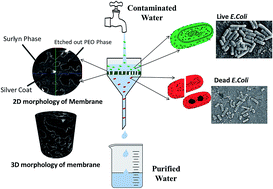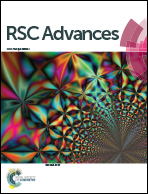Improving antifouling ability by site-specific silver decoration on polyethylene ionomer membranes for water remediation: assessed using 3D micro computed tomography, water flux and antibacterial studies
Abstract
Blending immiscible polymer blends often results in coarse microstructures due to interfacial driven coarsening. However, by introducing specific interactions between the constituents, the evolving microstructure can be tailor-made. Herein, water insoluble poly(ethylene-co-methacrylic acid) zinc salt (Surlyn) was blended with water soluble polyethylene oxide (PEO) in 50/50 (wt/wt) ratio to construct co-continuous structures that were not possible by blending PE and PEO at the same fraction. By selectively etching the water soluble phase (PEO), porous membranes can be designed with well-defined microstructure as assessed using X-ray micro-computed tomography and the pure water flux across the membranes was studied systematically. In order to impart an antibacterial surface, silver was directly reduced on the membrane surface utilizing the un-neutralized carboxylic acid moieties present in Surlyn as the reducing sites. This led to uniform decoration of silver on the surface which enhanced the antibacterial and antifouling properties. The presence of silver on the membrane was confirmed by X-ray photoelectron spectroscopy (XPS). The distribution of silver and the morphology of the porous Surlyn membrane was evaluated by field emission scanning electron microscopy (FESEM) coupled with EDAX analysis. The antibacterial activity was assessed using a standard plate count method wherein the bacterial cells were in direct contact with the silver decorated membranes. The content of silver present on the surface and the sustained release from the membrane surface was monitored using inductively coupled plasma optical emission spectrometry. The present study opens new avenues in designing efficient and scalable antibacterial membranes.



 Please wait while we load your content...
Please wait while we load your content...